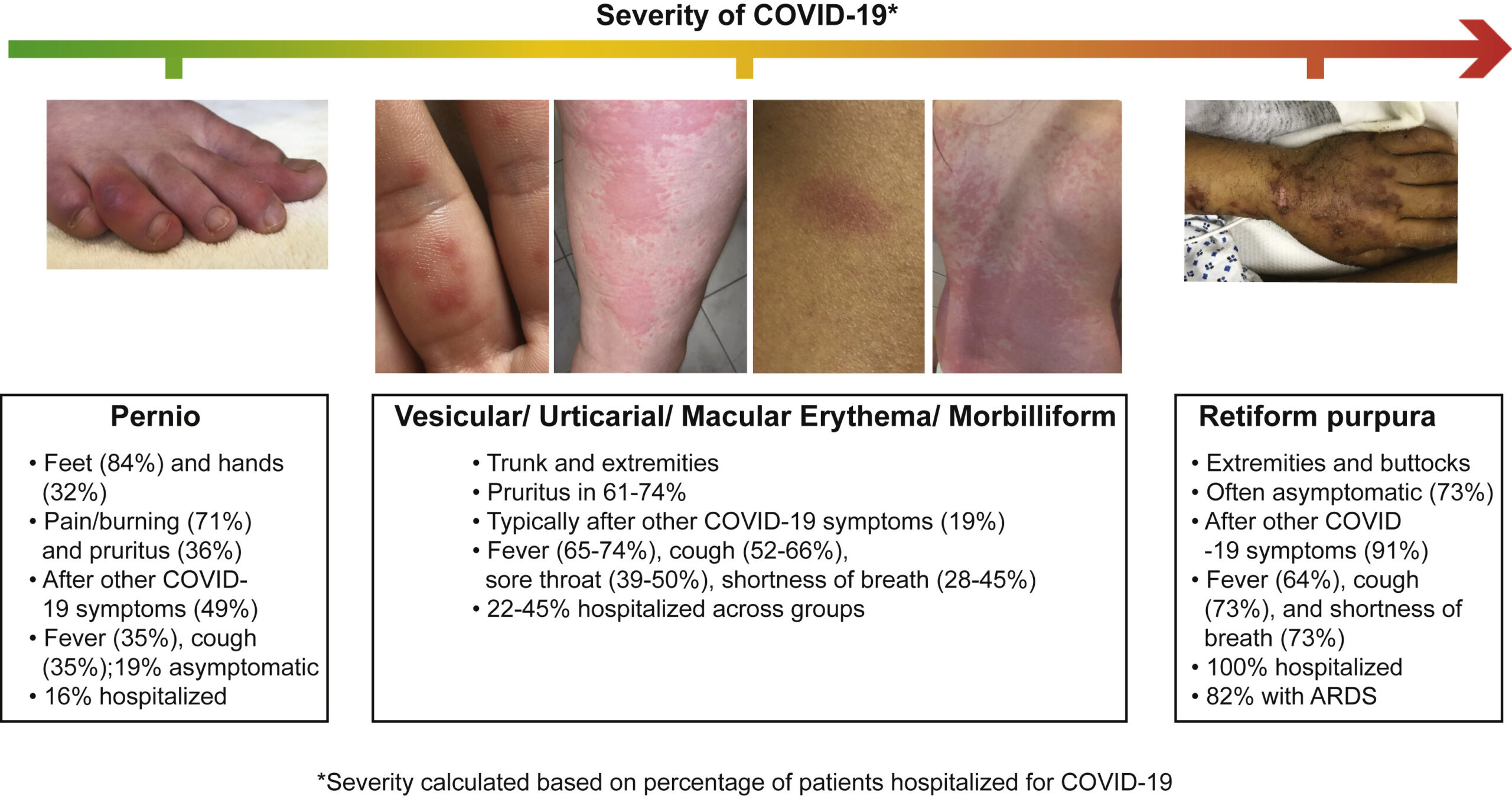COVID-19
Coronavirus disease (COVID-19) is an infectious disease caused by a newly discovered coronavirus called severe acute respiratory syndrome coronavirus 2 (SARS-CoV-2). Most people who fall sick with COVID-19 will experience mild to moderate symptoms and recover without special treatment.
How it spreads
The virus that causes COVID-19 is mainly transmitted through droplets generated when an infected person coughs, sneezes, or exhales. Generally, these droplets are too heavy to hang in the air and quickly fall on floors or surfaces. You can be infected by breathing in the virus if you are within close proximity of someone who has COVID-19, or by touching a contaminated surface and then your eyes, nose or mouth.
To know more about COVID-19 and it’s associated clinical features, check out this link: https://www.who.int/emergencies/diseases/novel-coronavirus-2019
COVID-19 and Skin1
COVID-19 has many effects on our skin, hair and nails. Some of the conditions are directly due to the disease and some of them are due to reduced immunity after the infection and in some situations, even because of the medicines taken for COVID-19. Expertise in recognising these signs could be an opportunity to improve diagnosis and management like the well-described association with loss of smell (anosmia) which prompts suspicion for SARS-CoV-2 infection. In an effort to have an extensive database of skin manifestations, health care workers around the globe have submitted data for possible cutaneous manifestations of confirmed or suspected cases of COVID-19.
The most common morphologies of skin rash were:
- Morbilliform (22%)
- Pernio-like (18%)
- Urticarial (16%)
- Macular erythema (13%)
- Vesicular (11%)
- Papulosquamous (9.9%)
- Retiform purpura (6.4%)
A minority of patients presented with multiple morphologies which included two or more patterns of the above in varying combinations.
When does it occur?
- After the symptoms – 64%
- During the symptoms – 15%
- Before the symptoms – 12%
- Asymptomatic – 9%
Lesions generally occurred after the symptoms subsided.
How long will it last?
Skin symptoms and affected body sites varied depending on the morphology. For example, the morbilliform rash was often associated with itching and involved the trunk, whereas pernio-like often caused pain/burning and involved the feet/hands. Retiform purpura was on the extremities and buttocks. The rashes lasted an average of 7 days (3-10 days). Pernio-like has a longer course, with an average of 14 days (8-24 days).
What should I do?
Do not worry if you have skin manifestations as they are generally not life-threatening. If you have developed a skin rash due to COVID-19, then it is important to follow the guidelines and remain in quarantine or the hospital and continue the isolation or treatment as suggested by your physician. That will depend on the severity of the infection and the symptoms of the infection. In addition, if the lesions are symptomatic and causing discomfort then you can consult a skin specialist near you.
Other Skin Manifestations
Herpes Zoster: It is a viral infection that affects the skin and nerves. They may occur after COVID-19 infection or in some cases even after vaccination. It is important to treat the condition early as that can help in full recovery and prevent long term nerve pain.
Other opportunistic infections: Many other fungal and other microbial infections may affect the skin due to reduced immunity during or after COVID-19 infection and sometimes, even due to the medicines taken for the infection.
Skin Necrosis: The patient often requires invasive mechanical ventilation which can cause pressure injury on the nose, cheeks and other parts of the face. Pressure injury on the buttocks due to prolonged hospitalisation is also common.
Skin peeling: This is usually seen in the palms and soles after the patient has recovered from COVID-19 and is also known as acral desquamation. The prevalence of hand dermatitis has also increased due to frequent use of alcohol-based sanitisers.
Hair shedding: Also known as telogen effluvium, it is a self-limiting condition that may occur within 6 months of infection and can take a few months to recover from.
Why does COVID-19 cause skin changes?
Although we have identified various dermatologic manifestations of COVID-19 to improve understanding of SARS-CoV-2 pathophysiology, the exact cause remains unknown. Previously, Suchonwanit et al proposed that cutaneous manifestations may present in 2 mechanistic patterns. Although this suggested dichotomy is a loose framework, it may prove a good starting point to consider our findings:
- Clinical features similar to viral exanthems, an immune response to viral nucleotides
- Cutaneous lesions are secondary to systemic consequences, especially vasculitis and thrombotic vasculopathy.
Conclusion
The study is limited by the constraints of a case series, which cannot accurately estimate the prevalence or incidence of these findings. The incidence of COVID-19 dermatologic manifestation remains unclear, with studies reporting 0.2% to 20%. There also remains the possibility of bias due to attribution error, given the reliance on providers’ judgment in entering data regarding whether findings were virus related, were from a medication, or were from other causes. Although providers were prompted for case updates, most reports represent a single snapshot, preventing full observation of dermatologic manifestations, disease complications, and follow-up testing.
However, the study goes a long way to show the patterns of skin manifestations due to COVID-19 and can help provide vital information to healthcare providers and patients.
For more information on skin and hair manifestations due to COVID-19, contact a certified dermatologist.
- Journal of the American Academy of Dermatology – Volume 83 Issue 4 Pages 1118-1129 (October 2020) DOI: 10.1016/j.jaad.2020.06.1016

